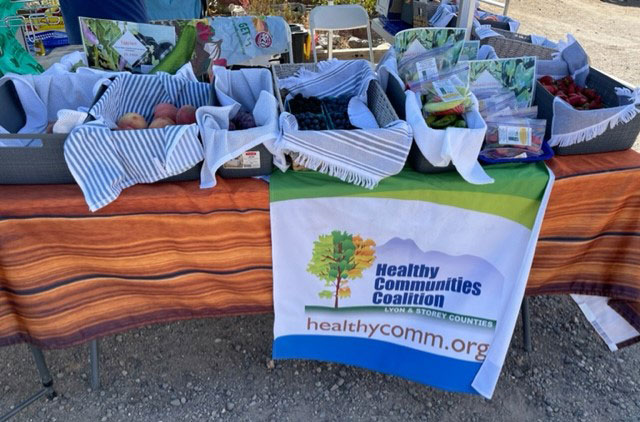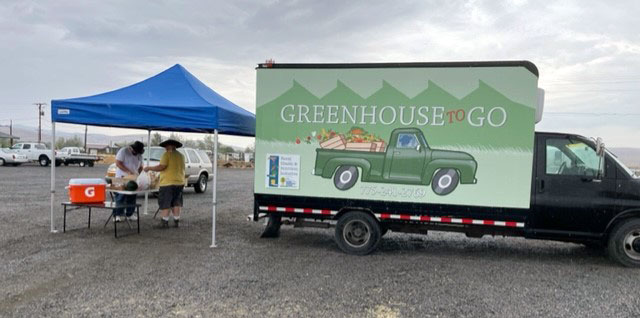Healthy Communities Coalition of Lyon and Storey Counties (HCC)
- Need: To increase access to healthy foods in two rural Nevada counties.
- Intervention: HCC and the Rural Health and Nutrition Initiative (RHNI) run food pantries, assist with community and school gardens, and have a farmers market during the summer.
- Results: The three food pantries together serve about 3,600 people and distribute over 100,000 pounds of food each month.
Description
Lyon County and Storey County in Nevada are considered food deserts, with little access to fresh fruits and vegetables. In order to increase access to healthy foods, the Healthy Communities Coalition of Lyon and Storey Counties (HCC) created the Rural Health and Nutrition Initiative (RHNI). HCC and RHNI operate programs such as food pantries; assist with community and school gardens; work with Lyon County schools with student nutrition and mental health programs; and conduct dental clinics in Lyon and Storey counties.

Services offered
HCC has open meetings, which any community member can attend. Coalition members work on strategy teams concerning healthcare access, food security, job training, senior services, substance use prevention, and youth services, among other issues.
HCC and RHNI operate:
- 3 food pantries, one of which delivers food to people who don't have transportation
- Assistance with community gardens in Dayton, Silver Springs, and Silver City
- Farmers market, which accepts SNAP benefits; Senior Farmers Market Coupons; and Women, Infants, and Children (WIC) Farmers Market Coupons
- Assistance with school garden programs at 6 schools in Lyon County
RHNI grows food to donate to food pantries and to sell at farmers markets. In addition, local restaurants can buy fresh produce directly from RHNI.
In Dayton, Silver Springs, and Yerington Food Pantries, HCC is implementing the Colorado State University program Eating Smart, Being Active, which includes engaging and hands-on activities covering topics like food safety, cooking, and food resource information.
Results
The three food pantries together serve about 3,600 people and distribute over 100,000 pounds of food each month. Adults 60 years or older account for 26% of the client population. Education is provided at food pantries to increase knowledge about healthy choices, recipes, and budgeting.
Program organizers are hoping to expand RHNI to include a commercial kitchen, cooking workshops, food demonstrations, summer work study programs, vegetable nursery, and youth internships. In addition, HCC is working on a food systems project to mentor and support local small farmers and other food producers, educate consumers on where to purchase local food, and reduce food waste.
Challenges
Reaching SNAP recipients is not always easy. Through social media, newsletters, and training, HCC and RHNI are starting to reach more SNAP recipients and explain how they can use and benefit from different services.

Contact Information
Linda Flaherty, Events CoordinatorHealthy Communities Coalition of Lyon and Storey Counties
linda@hcclsc.org
Topics
Community and faith-based initiatives
· Community engagement and volunteerism
· Farmers and farmworkers
· Food security and nutrition
States served
Nevada
Date added
December 5, 2022
Suggested citation: Rural Health Information Hub, 2025 . Healthy Communities Coalition of Lyon and Storey Counties (HCC) [online]. Rural Health Information Hub. Available at: https://www.ruralhealthinfo.org/project-examples/1104 [Accessed 4 January 2026]
Please contact the models and innovations contact directly for the most complete and current information about this program. Summaries of models and innovations are provided by RHIhub for your convenience. The programs described are not endorsed by RHIhub or by the Federal Office of Rural Health Policy. Each rural community should consider whether a particular project or approach is a good match for their community’s needs and capacity. While it is sometimes possible to adapt program components to match your resources, keep in mind that changes to the program design may impact results.
